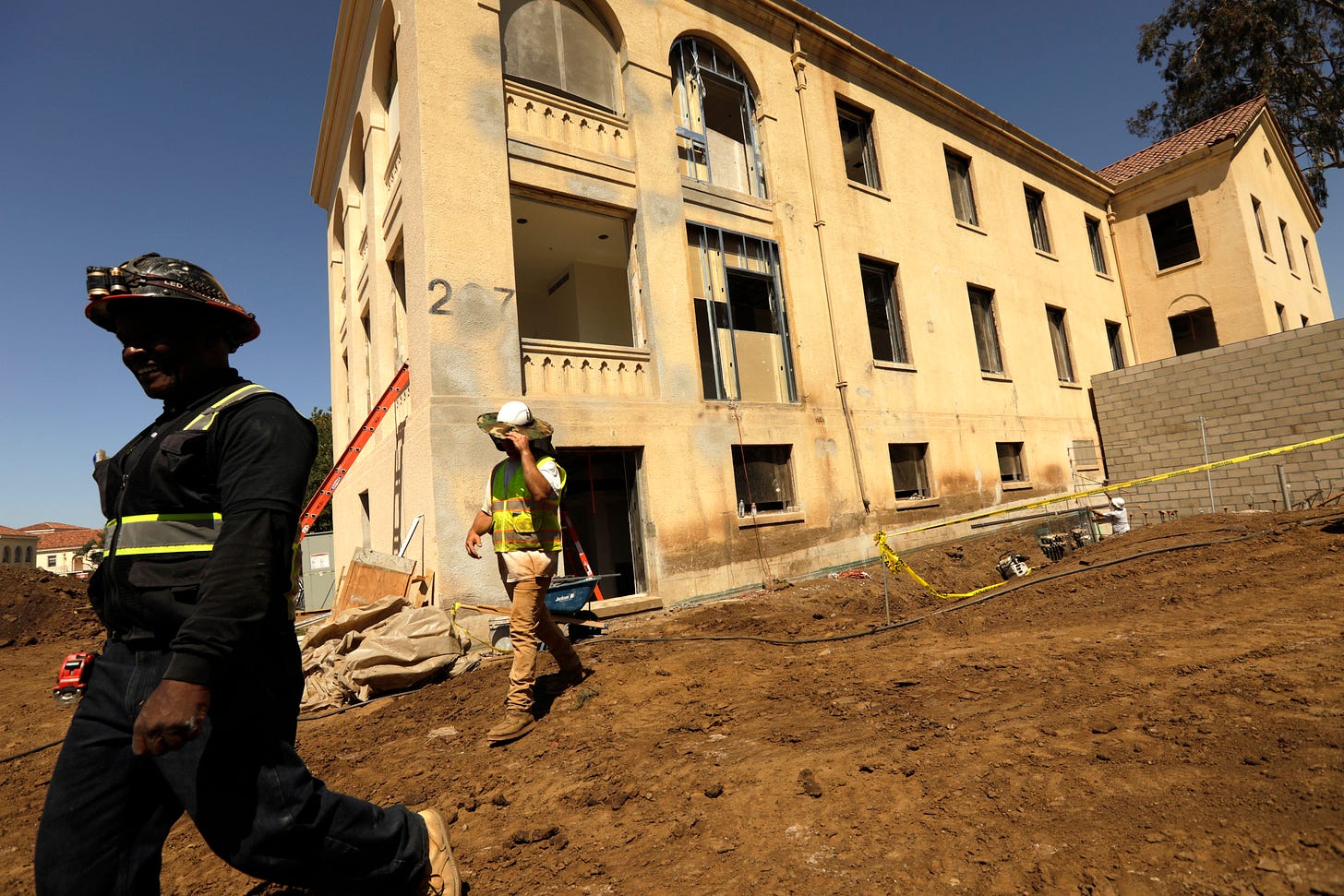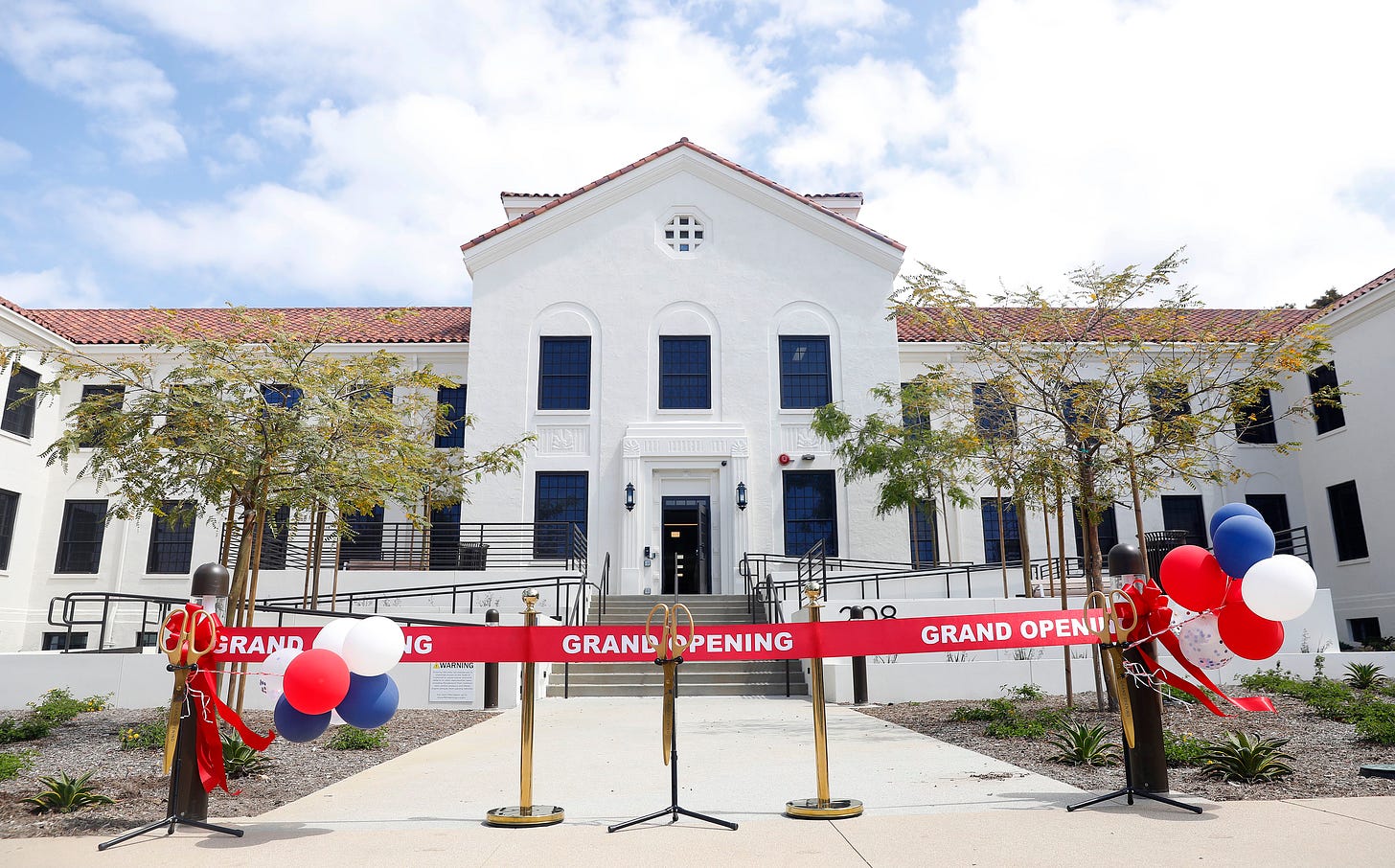Day 8: How VA builds — and doesn't build — veteran housing
The enhanced-use lease program got a thorough examination. Also, a settlement offer that surprised Judge Carter. “You want an initial impression? I’ll put it on the record: Whoa.”

Editor’s note: The following has been edited to correct errors introduced in our rush to publish daily courtroom briefings. A list of corrections can be found at the bottom. We regret the errors and thank our readers for alerting us to them.
Dueling interpretations of the VA’s ability to construct housing on the West Los Angeles campus were featured in court Thursday as Powers v. McDonough entered its eighth trial day.
The plaintiffs called to the stand C. Brett Simms, executive director of the VA’s Office of Asset Enterprise Management.
Simms explained that he oversees capital budget requests for VA’s construction projects, its Enhanced-Use Lease program and its real property. Jasper Craven interviewed Simms and John Kuhn during his reporting for Home of the Brave and published the conversation as a Q&A prior to the start of the trial.
After summarizing Simms’ responsibilities and purviews, plaintiff’s counsel Roman Silberfeld asked Simms about the VA’s authority to construct permanent supportive housing.
Silberfeld asked Simms about clauses in the 2016 West Los Angeles Leasing Act which state that the VA secretary “may carry out” “any enhanced-use lease of real property… for purposes of providing supportive housing, as that term is defined in section 8161(3) of such title, that principally benefit veterans and their families.”
Simms stated that according to the interpretation of the law by Robert Davenport, chief counsel of the VA’s real property law group, “that is the only method to deliver housing.” Earlier in the week, Steven Braverman, director of the VA’s Desert Pacific Healthcare Network, had invoked Davenport’s interpretation during his testimony.
Judge David Carter asked Simms if it was written anywhere.
“It would be in the enhanced use lease policy,” Simms answered.
“My question, fundamentally, is are there other ways in which the VA can build permanent supportive housing, other than through the enhanced use lease (law)?” Silberman asked.
“I do not believe there are,” Simms said.
Silberfeld noted that the VA had renovated Building 209, a residential building, using its own funds and authority.
Simms answered that the project had “explicit consent” to be built as part of the Compensated Work Therapy program in which veterans live in building 209 but work jobs both on campus and off.
“It was not general-purpose housing,” Simms said.
“I’m not saying it was,” Silberfeld said.
Why Building 209 changed

Building 209 was a 55-unit building that accommodated veterans participating in a transitional Compensated Work Therapy program, an initiative that has been popular among veterans and that the VA continues to promote today.
According to Vince Kane, who in 2015 was a special adviser on homelessness to VA Secretary Bob McDonald, as the building came online, other homelessness solutions were being explored. “The thinking was that it needed to be more consistent with the vision and the mission of the campus, which was to create permanent housing and to target the aging, chronically homeless, those suffering from serious mental illness,” Kane said when he was interviewed for Home of the Brave.
But when the 2016 West LA Leasing Act was signed into law, the VA got the legal authority to outsource both building and case management services for veterans to outside groups. “So that building transitioned from its original intent” as a Compensation Work Therapy unit, Kane said. It went from being temporary housing that helped vets stabilize their lives as they began to work jobs that paid enough for them to afford housing to permanent supportive housing for aging, homeless, and disabled vets. “That was considered a more effective and more needed solution to end veteran homelessness,” he said.
For more, read “Carving up the Map,” Part Four of Home of the Brave.
Silberfeld also asked Simms about the domiciliary located at the VA Greater Los Angeles, a residential facility for substance abuse treatment.
“The domiciliary was created by the VA, using its funds, not an enhanced use lease, correct,” Silberfeld asked.
“Correct,” Simms answered. Silberfeld then asked how that was accomplished using VA funds, not an enhanced use lease.
“The domiciliary is explicitly listed as a type of medical facility that we can build with our programs,” Simms answered.
Later during questioning, Silberfeld asked if Davenport ever cited to Simms any other statute or policy or rule that justifies the position that the VA cannot build permanent supportive housing.
The defense objected on the grounds of attorney-client privilege. Carter overruled the objection.
We always focused on congressional intent, Simms answered. “Congressional intent and their policy direction to us was very clear that the EUL program is how (housing) should be delivered,” he said.
Writer Spotlight : Jasper Craven
One of many journalists who collaborated on Home of the Brave, Jasper Craven specializes in the military and veterans' issues for publications including The New York Times, The Atlantic, The New Republic, and The Nation. Depth Perception, Long Lead’s newsletter highlighting in-depth journalists, interviewed Craven this summer and asked for a list of his favorite veteran-oriented journalism. Read his picks here.
Prior to Simms’ testimony, the court heard continued testimony from Michael Seeger Dennis, senior program advisor at HUD.
Questioned by the plaintiffs, Dennis reiterated that although HUD no longer considers veterans’ disability payments as income for the purposes of housing eligibility, issues still remain with Treasury Department policies.
According to a VA study, only 3% of applicants did not meet income requirements for the HUD-VASH (Veterans Affairs Supported Housing) voucher program.
Dennis said the “real problem” is housing built with low-income housing tax credits, which have their own income eligibility requirements set by the Treasury Department.
In yesterday’s testimony, Dennis testified about barriers to implementing HUD’s proposed rule change. For example, the HUD policy — because it’s a federal rule — wouldn’t impact income requirements on state and locally financed housing that require income restrictions, which means disability payments could still block veterans from being eligible for housing.
Carving up the map
After prohibiting veterans from living permanently on land donated to house them, the VA entangled itself in a wild array of leases on the valuable Los Angeles property — from soccer pitches to parrot sanctuaries — inhibiting the government from solving a homeless crisis of its own creation.
If the VA isn’t housing veterans on this land, what is the property for? Learn more by reading Part Four of Home of the Brave.
After Dennis was dismissed, the plaintiffs called Jonathan Sherin, a psychiatrist with a Ph.D in neurobiology who worked at the West LA VA starting in 2003 as a staff psychiatrist, and eventually became the facility’s chief of psychiatry and mental health programs. He has experience in advocacy and specialized knowledge in homelessness — particularly among veterans — as well as mental health and addiction.
Sherin served as a special consultant in the Valentini settlement, and he helped develop the 2016 Master Plan. The big idea is to create an intentional community, he said. The Master Plan would help create not only housing units but a place with a range of other resources (medical, emotional, career, financial) where even veterans from outside the campus could congregate, he added.
But Sherin also acknowledged the importance of housing. “Housing is definitely a heath care issue for me,” he said. “Homelessness is deeply traumatic.”
Being homeless for any period of time presents stressors to veterans, Sherin said. “These stressors, en masse, generate a serious amount of mental illness.”
Sherin was critical of the government’s response to veteran homelessness. “Speed of response has been entirely inadequate,” he said. “And the breadth has been narrowed so that the intentional community has been modified into a housing project.”
“I do worry that just housing without anything to do is a setup for bad outcomes,” Sherin said. Nonetheless, he said something should be done to house veterans immediately.
“Veterans in who are homeless in Southern California need housing today they need it now,” Sherin said.
Carter weighed in on Sherin’s testimony. “The VA has a problem and it's called Congress,” he told Sherin.
They, Carter said gesturing to the defense table, can’t go to Congress with an idea. “They need dollars and cents,” he said.
Carter advised Sherin and the VA to negotiate what “a reasonable figure” of housing units might be. “You can’t just walk in and say we want 10,000 — you're dead on arrival,” he said.
But Carter seemed to express support for Sherin’s philosophy for a reimagined GLA campus. “Is there any better therapy than a veteran talking to another veteran?” Carter asked.
“No,” Sherin said.
“Therefore if you’ve got a community of other veterans you’ve got the best therapy?”
Sherin agreed.
“The VA has a problem, and it's called Congress.” —Judge David O. Carter
As the day drew to a close, however, Carter expressed much less enthusiasm for a settlement between plaintiffs and Bridgeland, which operates a drill site on the campus, that is a co-defendant in the Powers v. McDonough suit.
The settlement would see Bridgeland increasing the royalty payments on its gross revenue up to 5 percent, paying it to an entity jointly designated by Plaintiffs and VA. Bridgeland would also grant back a 1 1/2-acre parcel of land adjacent to its drill site back to the VA for the express purpose of housing, a Bridgeland attorney explained. The drill site would still be operational.
Carter was incredulous. “Why would I put long-term supportive housing next to an oil well especially if I have people (veterans) who are involved with burn pits, asthma, and Agent Orange?” he asked.
“I’m not going to pre-judge this but, whoa,” he said, addressing both the Bridgeland attorney and Silberfeld. “You want an initial impression? I’ll put it on the record: Whoa.”
Proceedings for Powers v. McDonough will continue on Wednesday, August 21 at 8:00 a.m.
Friday, Aug. 16: The following is a list of corrections to the original publication of this daily news brief.
Jonathan Sherin was originally identified as a psychologist and neurobiologist. The story has been changed to reflect that he is a psychiatrist with a Ph.D in neurobiology.
Sherin was originally identified as “working at the VA Greater Los Angeles campus and turned to veteran healthcare advocacy.” The story has been changed to reflect that he worked at the West LA VA starting in 2003 as a staff psychiatrist, and eventually became the facility’s chief of psychiatry and mental health programs.
The original story said Sherin “turned to veteran healthcare advocacy.” The story has been updated to say Sherin has experience in advocacy and specialized knowledge in homelessness — particularly among veterans — as well as mental health and addiction.
Sherin was originally identified as having input on the 2022 Master Plan. The story has been changed to reflect that he served as a special consultant in the Valentini settlement, and he helped develop the 2016 Master Plan.
Sherin was originally identified as “slamm[ing] the governmental response to the Valentini settlement which, like the 2022 Master Plan, calls for the construction of additional temporary and permanent housing units.” The story has been changed to reflect that he was critical of the government’s response to veteran homelessness.








